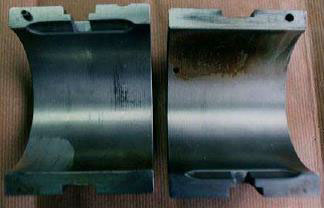Bearing Damage Index
Lacquering
Sometimes a light brown deposit is observed in the hottest area of a bearing surface. Usually this is harmless, but in some cases it can build up to a sufficient thickness to adversely affect the bearing oil film and cause local overheating of the bearing surface, leading to fatigue or intergranular craze cracking.
This phenomenon is temperature dependent but is also affected by the oil chemistry. Many mineral oils will form a lacquer if the bearing surface temperature exceeds 130°C (266°F), but lacquer can be formed at much lower temperatures if the oil is contaminated or its air release time is outside specification. Synthetic oils can form lacquer if contaminated by hydrocarbons.
Addressing the Damage
Check the condition of the oil and change the oil if necessary. The lacquering may be caused by oil breakdown or contamination.
If excessive surface temperature is the cause of the lacquering, consult a bearing engineer for bearing designs that will operate at a lower temperature.


Figure 1: Lacquering in offset halves of a tin-based whitemetal journal bearing; the resultant loss of clearance has led to intergranular craze cracking

